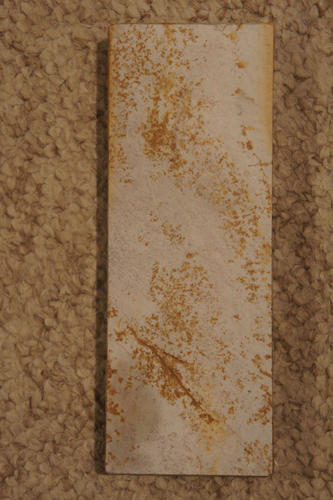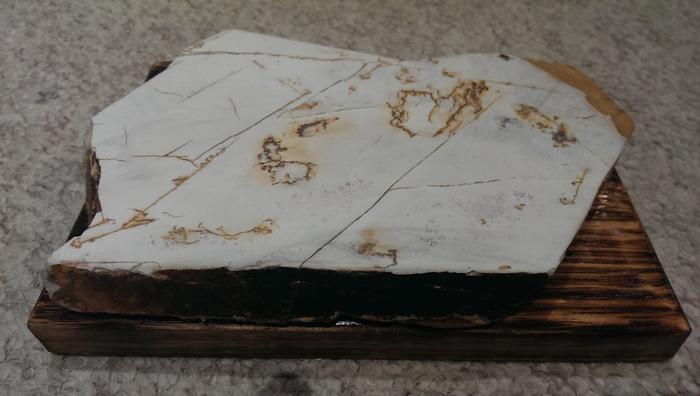Results 41 to 48 of 48
-
10-31-2013, 10:13 AM #41< Banned User >

- Join Date
- Dec 2012
- Location
- Long Island NY
- Posts
- 1,378
Thanked: 177
Im sure this stone swarf and slurry acidic reaction takes place, but anything that strong would be at least partially neutralized by the water which cannot be too acidic as that would be harmful to the plumbing and I mean the water companies mains which costs big money. I don't leave swarf on my stones and always wipe off and Typically if I leave something for the next day I will do the same.
-
10-31-2013, 04:01 PM #42

A pH rhyme from D. Kolb (1979). Journal of Chemical Education, 56, 53:
For coffee it's 5, for tomatoes it's 4;
While household ammonia is 11 or more.
It's 7 for water, if in a pure state,
But rain water is 6, and sea water is 8.
It's basic at 10, quite acidic at 2,
And well above 7 when litmus turns blue.
Some find it a puzzlement. Doubtless their fog
Has something to do with that negative log.Hur Svenska stålet biter kom låt oss pröfva på.
-
10-31-2013, 11:38 PM #43

Interesting results Brighty. Do any of these random stones cause the rusty slurry syndrome when honing ?
The white gleam of swords, not the black ink of books, clears doubts and uncertainties and bleak outlooks.
-
11-01-2013, 12:45 AM #44

To be honest I have never really looked for it when honing, even if I did see it I wouldn't have put 2 and 2 together lol. I will try to keep any eye out though. Do you have a stone that causes this and can you post a pic of the results?
FYI, the stone that caused the biggest result is this one.

Yaginoshima suita
-
11-01-2013, 04:31 AM #45

Yep. My Yaginoshima Asagi causes rusty slurry. Do you use that Suita on knives ? Fast stone ?
The white gleam of swords, not the black ink of books, clears doubts and uncertainties and bleak outlooks.
-
11-01-2013, 06:24 AM #46

Yeah, that slurry looks familiar! I have quite a few stones that have that same slurry.
The suita is a fast cutter, it not a finisher although I can still shave off it. I've used it for a few knives and it gives my knives a razor edge It produces a brown\black slurry quite quickly.
It produces a brown\black slurry quite quickly.
This Okunomon Suita has almost the same characteristics.

Im guessing these would produce the same slurry\preform much the same as your Okudo Suita except your stone is probably a little harder?
-
11-01-2013, 06:55 AM #47
-
11-02-2013, 10:04 PM #48

There is a huge difference between etching, pH and rust.
First of all, about rust; The easiest way to interpret this is, particles of rust inside the stone. Could be the way they came out of the earth, or it could be because someone used the stone for honing and forgot to clean it. It rusted, particles went inside the stone. Rust is a catalyst for more rust. If it was clean, nothing would happen, for a short time. But a single molecule, and bad things happen fast.
The finer the powder i.e. slurry, the faster it happens. And, when it happens, more rust is absorbed from the stone. So, keep your stones clean.
About the acid, the rock can't have acidic nature. Stones have been used with soda powder in their water for many decades. If the stone was acidic, we would most certainly know it by now from, including but not limited to, bubbles that come from the reaction. Or explosions and poisonous gasses or something. Insoluble acidic minerals are quite rare, and in most cases carbon dioxide is the (weak) "acid", next to a strong base with limited solubility. On the other hand, basic minerals are extremely common. Silicon oxide is also an acid. Again, pretty weak acid, and insoluble. But reacts with strong bases.
If the stone was acidic, the rust would be the last thing to worry about.
And, for the etching, are you sure it's not a polishing effect? I have seen many cool ones, depending the abrasive and what it contains.
I've been reading the thread for a while, so, those are my two cents, good luck.


 16Likes
16Likes LinkBack URL
LinkBack URL About LinkBacks
About LinkBacks






 Reply With Quote
Reply With Quote

